If you have made it here, you undoubtedly have worked with some sort of microfilm, but do you know all the different types? Within the world of microfilm there are many film varieties. As printing technology changed and processes advanced, so did microfilm production. Depending on the need of the company or organization, formats and types ranged from standard to custom. Microfilm, for the most part, can be divided into type, size, and printing process. This article addresses some of the more common types of microfilm that can be scanned using nextScan’s FlexScan+ Multi-Format Production Microfilm Scanner.
Roll Film
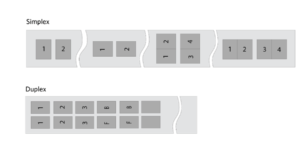 Roll film reels are wound with strips of film, usually around 100ft to 200ft in length, with some reaching 1000ft. These strips of film can come in a variety of widths and containers. The most common sizes of film are 16mm and 35mm. Within these sizes exist simplex, duplex, duo, and duo duplex layouts. The most common are simplex and duplex. That is, a singular frame along the strip (simplex) or two frames along the strip of film (duplex).
Roll film reels are wound with strips of film, usually around 100ft to 200ft in length, with some reaching 1000ft. These strips of film can come in a variety of widths and containers. The most common sizes of film are 16mm and 35mm. Within these sizes exist simplex, duplex, duo, and duo duplex layouts. The most common are simplex and duplex. That is, a singular frame along the strip (simplex) or two frames along the strip of film (duplex).
Cartridge Film
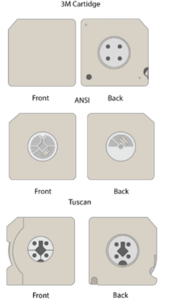
A subcategory of roll film would be roll film contained in cartridges. Cartridges serve the purpose of protecting roll film from external elements. The most common cartridges available are M-cartridge types, ANSI cartridges, and Tuscan SnapLOCK cartridges. M-cartridge types are durable plastic cases with a round metal axis in the center. This axis has four holes aligned in an even square.
ANSI Cartridges are plastic outer cases, also known as C-Clips. They wrap around the roll film so that a spindle will still slot into the opening in the reel.
Tuscan SnapLOCK cartridges are similar to 3M in that they are a full cartridge encasing the film. Unlike the 3M, the Tuscan SnapLOCK can use a spindle.
Blipped Film
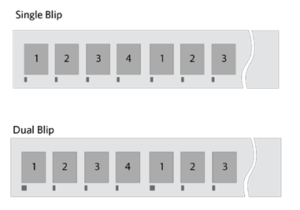 Another type of roll film, blipped film, has indication marks below the frames for reading purposes. There can be up to three levels of blips. A single blip will be a consistent size while a double or triple blip will have small and large blips. The largest blip will usually denote a folder, larger blips will indicate the start of a document, while the small blips are read as pages within that document. There are also non-blipped frames which can serve a variety of purposes depending on how the reels were set up.
Another type of roll film, blipped film, has indication marks below the frames for reading purposes. There can be up to three levels of blips. A single blip will be a consistent size while a double or triple blip will have small and large blips. The largest blip will usually denote a folder, larger blips will indicate the start of a document, while the small blips are read as pages within that document. There are also non-blipped frames which can serve a variety of purposes depending on how the reels were set up.
Fiche
Fiche are flat sheets containing multiple frames in columns and rows. These frames can be laid out either horizontally or vertically. Fiche, like roll film, comes in the common sizes of 16mm and 35mm, but can also contain more unusual sizes. The size of the film usually depends on the purpose of what is printed on the fiche.
Common Fiche Sizes
|
105 mm x 148 mm – Standard |
85.7 mm x 187.3 mm – Ultra Fiche |
|
105 mm x 148 mm- 105mm Fiche |
76.2mm x 127mm – Mini Fiche |
|
77 mm x 127 mm – Standard |
117.5 mm x 148 mm – AB Dick |
|
16 mm and 35 mm Mixed Jackets |
127 mm x 203.2 – Jumbo |
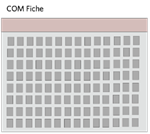 COM Fiche, or Computer Output Microfiche, are fiche that were created by printing directly from a computer to a fiche creating a uniform appearance. Jacketed Fiche are fiche made with film strips or single frames that have been inserted into a protective sheet, or “jacket”. These sheets have multiple rows with one side open, making it easy to add or remove film to modify the fiche. Most film within a jacketed fiche are 16mm, 35mm, or a mix of the two. As archives often have multiple formats, the FlexScan has been designed to handle multiple formats and sizes of fiche to make the process easy for any user. It also has an optional
COM Fiche, or Computer Output Microfiche, are fiche that were created by printing directly from a computer to a fiche creating a uniform appearance. Jacketed Fiche are fiche made with film strips or single frames that have been inserted into a protective sheet, or “jacket”. These sheets have multiple rows with one side open, making it easy to add or remove film to modify the fiche. Most film within a jacketed fiche are 16mm, 35mm, or a mix of the two. As archives often have multiple formats, the FlexScan has been designed to handle multiple formats and sizes of fiche to make the process easy for any user. It also has an optional 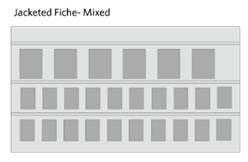 automatic fiche loader that can scan up to 720 fiche per hour, eliminating the need to hand feed and allow the user to audit the scans while additional fiche are being scanned.
automatic fiche loader that can scan up to 720 fiche per hour, eliminating the need to hand feed and allow the user to audit the scans while additional fiche are being scanned.
Aperture Card
An aperture card is aptly named as it consists of a card with a rectangular opening where a frame is mounted. The common sizes for these frames are 35mm and 16mm. These can be either one-up or two-up. A two-up card will have two apertures vs.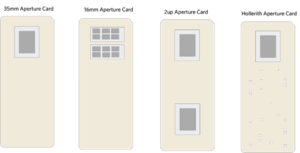 the one-up cards that only have one aperture.
the one-up cards that only have one aperture.
Hollerith cards are a form of aperture card with added Hollerith hole punches that contain information about what is displayed on the film. This information is usually also printed on the card itself.
While the Flexscan+ can’t interpret Hollerith punches, it can scan the information printed on the card, which often includes notes that were added after the initial creation of the card.
Emulsion Types
Film can be further divided into the chemical processes used to produce it. These can be identified by color as well as shine. There are pros and cons to each type and often the choice of which to use comes down to purpose, storage environment, and usage.
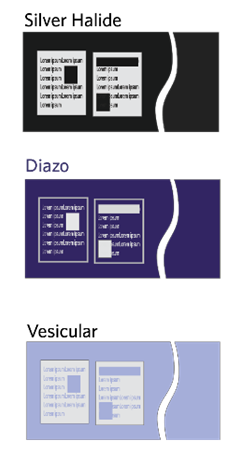 Silver Halide has a dull and shiny side to the film due to the chemical processes on each side. This is the clearest and most accurate form of film. However, silver halide can scratch easily, making handling and storage a delicate process. Most archives prefer this type of film for its accuracy and life expectancy if stored properly.
Silver Halide has a dull and shiny side to the film due to the chemical processes on each side. This is the clearest and most accurate form of film. However, silver halide can scratch easily, making handling and storage a delicate process. Most archives prefer this type of film for its accuracy and life expectancy if stored properly.
Diazo film is shiny on both sides of the film and can vary in color from purple-black, blue-black, or brown-black. This color aids with contrast when light is applied for reading. As long as it’s not oversaturated and stored properly, the Positive Diazo Duplicate is one of the best films that allow for access, durability, and clarity.
Vesicular film is considered semi-scratch resistant. The print is light blue in color and formed from bubbles between the film layers. Due to the fact it’s created with these bubbles, vesicular film can be ruined with heat, pressure, or fade with light exposure. In terms of quality, it’s similar to silver halide. It differs in that silver halide is resistant to light exposure but can be scratched easily, whereas vesicular film is scratch-resistant but susceptible to fading with exposure to light.
Rewriteable film, as the name suggests, is rewritable. While this filming solution makes it easy to reuse and reprint, it’s also considered a short-term record solution and questionable when it comes to records. Jacketed fiche are considered part of this group as frames can be added or removed.
With all the different microfilm types, finding the best solution for your archive can be overwhelming. Our FlexScan+ Multi-Format Production Microfilm Scanner offers multiple modules to make scanning any type of microfilm a breeze. At nextScan, we strive to find the best fit for our users to make conversion simple and frustration-free. If you’re struggling with your film collection or having trouble finding a solution to fit your needs, contact the conversion experts at nextScan to solve your microfilm issues.
